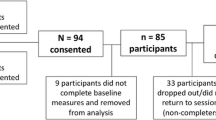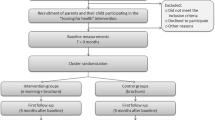Abstract
Community family educators have the opportunity to incorporate childhood obesity prevention concepts in their programming with families of young children, but often lack formal health and nutrition education. The purpose of this feasibility study was to create an online training certificate program for community family educators and assess the program’s effectiveness at improving participant’s knowledge, attitudes, and intended and actual behaviors related to healthy lifestyles. Community family educators (n = 68) completed an online pretest, viewed 13 brief videos (8–15 min) focused on childhood obesity related topics and took mini-knowledge self-checks after each video followed by an online posttest. At posttest, paired t tests showed participants’ childhood obesity prevention related knowledge (i.e., nutrition, physical activity, screen time and sleep) improved significantly (p < 0.001). Participants’ attitudes toward parenting behaviors related to feeding practices, family meals, physical activity, screen time control and parent modeling significantly (p < 0.05) improved. Improvements also were seen in participants’ intentions to promote obesity prevention behaviors (i.e., age appropriate portions sizes, adequate physically active, and parental role modeling). Furthermore, changes in personal health behaviors at posttest revealed participants had significantly (p < 0.05) greater dietary restraint, improvements in sleep quality, and reductions of use of electronic devices during meals and snacks. Overall, participants were very satisfied with the training program, felt comfortable with skills acquired, and enjoyed the program. Findings suggest this online training program is a feasible and effective method for improving community family educators’ knowledge, attitudes, and intentions for obesity-prevention related parenting practices.
Similar content being viewed by others
References
Liechty, J., Saltzman, J., & Musaad, S. (2015). Health literacy and parent attitudes about weight control for children. Appetite, 91, 200–208.
Child & Family Research Partnerships. (2013). CFRP policy brief: Involving fathers in home visiting programs: Lessons from the Dads. Austin, TX: The University of Texas at Austin.
Sandstrom, H., Healy, O., Gearing, M., & Peters, H. (2015). Serving young fathers in home visiting programs: Highlights from a research study (pp. 1–14). Washington, DC: Urban University.
Ogden, C., Carroll, M., Kit, B., & Flegal, K. (2014). Prevalence of childhood and adult obesity in the United States, 2011–2012. JAMA, 311(8), 806–814.
Baker, S. S., Pearson, M., & Chipman, H. (2009). Development of core competencies for paraprofessional nutrition educators who deliver food stamp nutrition education. Journal of Nutrition Education and Behavior, 41(2), 138–143.
Christofferson, D., Christensen, N., LeBlanc, H., & Bunch, M. (2012). Developing an online certification program for nutrition education assistants. Journal of Nutrition Education and Behavior, 44(5), 407–414.
Morrison, L., Fleming, L., Gray, C., Fleming, C., & Hamad, C. (2015). Online learning for early intervention professionals: Transition planning form early intervention to school. Journal of Special Education Technology, 28(2), 1–12.
Howatson-Jones, L. (2004). Designing web-based education courses for nurses. Nursing Standard, 19(11), 41–44.
Taylor, T., Serrano, E., Anderson, J., & Kendall, P. (2000). Knowledge, skills, and behavior improvements on peer educators and low-income Hispanic participants after a stage of change-based bilingual nutrition education program. Journal of Community Health, 25(3), 241–262.
Barlow, S. (2007). Expert committee recommendations regarding the prevention, assessment, and treatment of child and adolescent overweight and obesity: Summary report. Pediatrics, 120, S164–S192.
Martin-Biggers, J., Spaccarotella, K., Delaney, C., Koenings, M., Alleman, G., Hongu, N., et al. (2015). Development of the intervention materials for the homestyles obesity prevention program for parents of preschoolers. Nutrients, 7(8), 6628–6669.
Storfer-Isser, A., & Musher-Eizenman, D. (2013). Measuring parent time scarcity and fatigue as barriers to meal planning and preparation: Quantitative scale development. Journal of Nutrition Education and Behavior, 45(2), 176–182.
Wardle, J., Sanderson, S., Guthrie, C. A., Rapoport, L., & Plomin, R. (2002). Parental feeding style and the inter-generational transmission of obesity risk. Obesity Research, 2002(10), 6.
Ogden, J., Reynolds, R., & Smith, A. (2006). Expanding the concept of parental control: A role for overt and covert control in children’s snacking behaviour? Appetite, 47(1), 100–106.
Hughes, S., Power, T., Orlet, F., Mueller, S., & Nicklas, T. A. (2005). Revisiting a neglected construct: Parenting styles in a child-feeding context. Appetite, 44(1), 83–92.
Hughes, S., Cross, M., Hennessy, E., Tovar, A., Economos, C., & Power, T. (2012). Caregiver’s Feeding Styles Questionnaire: Establishing cut-off points. Appetite, 58(1), 393–395.
Spurrier, N., Magarey, A., Golley, R., Curnow, F., & Sawyer, M. (2008). Relationships between the home environment and physical activity and dietary patterns of preschool children: A cross-sectional study. International Journal of Behavioral Nutrition and Physical Activity, 5, 31.
Birch, L., & Davison, K. (2001). Family environmental factors influencing the developing behavioral controls of food intake and childhood overweight. Pediatrics of Clinical North America, 48(4), 893–907.
Faith, M., Storey, M., Kral, T., & Pietrobelli, A. (2008). The Feeding Demands Questionnaire: Assessment of parental demand cognitions concerning parent child feeding relations. Journal of the American Dietetic Association, 108(4), 624–630.
Tibbs, T., Haire-Joshu, D., Schechtman, K., Brownson, R., Nanney, M., Houston, C., et al. (2001). The relationship between parental modeling, eating patterns, and dietary intake among African-American parents. Journal of the American Dietetic Association, 101(5), 535–541.
Kremers, S., De Bruijn, G., Visscher, T., Van Mechelen, W., De Vries, N., & Brug, J. (2006). Environmental influences on energy balance-related behaviors: A dual-process view. International Journal of Behavioral Nutrition and Physical Activity, 3, 9.
Bryant, M., Ward, D., Hales, D., Vaughn, A., Tabak, R., & Stevens, J. (2008). Reliability and validity of the Healthy Home Survey: A tool to measure factors within homes hypothesized to relate to overweight in children. International Journal of Behavioral Nutrition and Physical Activity, 5, 23.
Neumark-Sztainer, D., Wall, M., Perry, C., & Story, M. (2003). Correlates of fruit and vegetable intake among adolescents: Findings from Project EAT. Preventive Medicine, 37(3), 198–208.
Neumark-Sztainer, D., Story, M., Hannan, P., Perry, C., & Irving, L. (2002). Weight-related concerns and behaviors among overweight and nonoverweight adolescents: Implications for preventing weight-related disorders. Archives of Pediatrics and Adolescent Medicine, 156(2), 171–178.
Trost, S., Sallis, J., Pate, R., Freedson, P., Taylor, W., & Dowda, M. (2003). Evaluating a model of parental influence on youth physical activity. American Journal of Preventive Medicine, 25(4), 277–282.
Sallis, J., Prochaska, J., Taylor, W., Hill, J., & Ceraci, J. (1999). Correlates of physical activity in a national sample of girls and boys in grades 4 through 12. Health Psychology, 18(4), 284–288.
Earls, F.J., Brooks-Gunn, J., Raudenbush, S.W., & Sampson, R.J. (2006). Project on Human Development in Chicago Neighborhoods (PHDCN): Stanford-Binet, Wave 2 1997–2000, ICPSR13652-v1. Ann Arbor, MI: Inter-university Consortium for Political and Social Research. doi:10.3886/ICPSR13652.v1.
Sallis, J., Prochaska, J., & Taylor, W. (2000). A review of correlates of physical activity of children and adolescents. Medicine and Science in Sports and Exercise, 32(5), 963–975.
Buysee, D., Reynolds, C., Monk, T., Berman, S., & Kupfer, D. (1989). The Pittsburgh Sleep Quality Index: A new instrument for psychiatric practice and research. Psychiatry Research, 28, 193–213.
Karlsson, J., Persson, L., Sjostrom, L., & Sullivan, M. (2000). Psychometric properties and factor structure of the Three-Factor Eating Questionnaire (TFEQ) in obese men and women. Results from the Swedish Obese Subjects (SOS) Study. International Journal of Obesity and Related Metabolic Disorders, 24(12), 1715–1725.
Berk, R. (1986). A consumer’s guide to setting performance standards on criterion referenced tests. Review of Educational Research, 56, 137–172.
Coscarelli, W., & Shrock, S. (2002). The two most useful approaches to estimating criterion-referenced test reliability in a single rest administration. Performace Improvement Quarterly, 15, 74–85.
Livingston, S. (1972). Criterion-reference applications of classical test theory. Journal of Educational Measurement, 9, 13–26.
Linn, R., & Gronlund, N. (1999). Measurement and assessment in teaching (8th ed.). New York: Merrill Co.
Ebel, R., & Frisbie, D. (1986). Essentials of educational measurements. Englewood Cliffs, NJ: Prentice-Hall Inc.
Gronlund, N. (1997). Assessment of student achievement (6th ed.). Boston, MA: Allyn & Bacon.
Neelon, S., & Briley, M. (2011). Position of the American Dietetic Association: Benchmarks for nutrition in child care. Journal of the American Dietetic Association, 111, 607–615.
American Academy of Pediatrics, American Public Health Association, & National Resource Center for Health and Safety in Child Care and Early Education. (2011). Caring for our children: National health and safety performance standards; Guidelines for early care and education programs. Elk Grove Village, IL: American Academy of Pediatrics.
Adedza, P., Orr, R. A., Chapman-Novakofski, K., & Donovan, S. (2013). Set the pace: Nutrition education DVD for head start parents. Journal of Nutrition Education and Behavior, 45(3), 279–281.
Stark, C., Graham-Kiefer, M., Devine, C., Dollahite, J., & Olson, C. (2011). Online course increases nutritonal professionals’ knowledge, skills, and self-efficacy in using an ecological approach to prevent childhood obesity. Journal of Nutrition Education and Behavior, 43(5), 316–322.
Neuenschwander, L., Abbott, A., & Mobley, A. (2013). Comparison of a web-based vs. in-person education program for low-income adults. Journal of the American Dietetic Association, 113(1), 120–126.
Wardel, J., Sanderson, S., Guthrie, C., Rapoport, L., & Plomin, R. (2002). Parental feeding style and the inter-generational transmission of obesity risk. Obesity Research, 10(6), 453–462.
Orlet, F., Mitchelle, D., Wright, H., & Birch, L. (2002). Parental influences on young girls’ fruit and vegetable, micronutrient and fat intakes. Journal of the American Dietetic Associateion, 102(1), 58–64.
Galloway, A., Fiorito, L., Francis, L., & Birch, L. (2006). ‘Finish Your Soup’: Counterproductive effects of pressuring children to eat on intake and affect. Appetite, 46(3), 1264–1272.
Spruijt-Metz, D., Lindquist, C., Birch, L., Fisher, J., & Goran, M. (2002). Relations between mothers’ child-feeding practices and chilren’s adiposity. The American Journal of Clinical Nutrition, 75(3), 581–586.
Ramsay, S., Holyoke, L., Branen, L. J., & Fletcher, J. (2012). Six characteristics of nutrition education videos that support learning and motivation to learn. Journal of Nutrition Education and Behavior, 44(6), 614–617.
Council of Research Excellence. (2009). Ground breaking study of video viewing finds younger boomers consume more video media than any other group. In R. Zackon (Ed.), Traditional television remain “800 Pound Gorilla” in video media arena (pp. 1–4). NY: New York.
National Sleep Foundation. (2016). How much sleep do we really need? National Sleep Foundation.
Funding
This study was funded by USDA NIFA (Grant #2011-68001-30170).
Author information
Authors and Affiliations
Corresponding author
Ethics declarations
Conflicts of interest
The authors declare that they have no conflict of interest.
Rights and permissions
About this article
Cite this article
Eck, K., Alleman, G.P., Quick, V. et al. Evaluation of a Childhood Obesity Prevention Online Training Certificate Program for Community Family Educators. J Community Health 41, 1187–1195 (2016). https://doi.org/10.1007/s10900-016-0200-z
Published:
Issue Date:
DOI: https://doi.org/10.1007/s10900-016-0200-z




